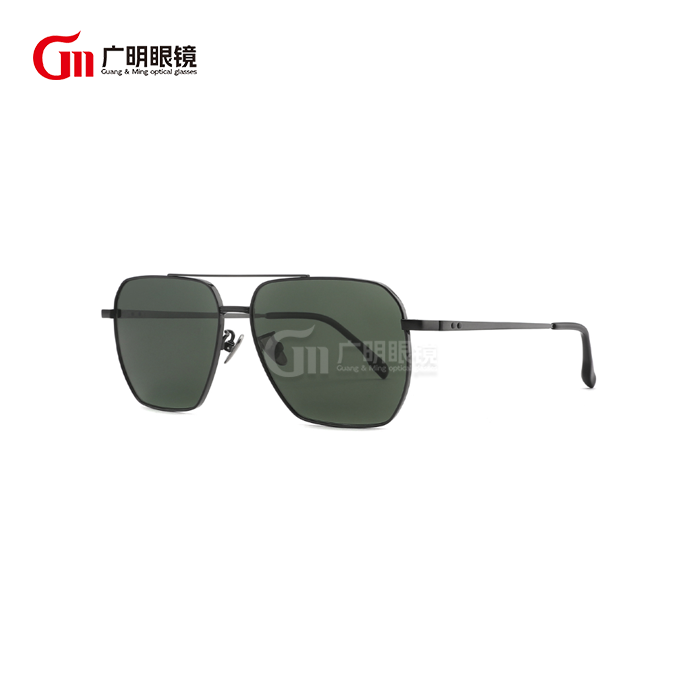How to Clean Hexagonal Mirrored Sunglasses?
Proper maintenance of premium eyewear requires specialized knowledge and careful attention to delicate coating systems that define modern optical performance. Hexagonal mirrored sunglasses represent sophisticated optical instruments that demand specific cleaning techniques to preserve their reflective properties and structural integrity. The mirror coating technology used in these specialized lenses can be easily damaged by improper cleaning methods, harsh chemicals, or abrasive materials. Understanding the correct cleaning procedures ensures that your investment in quality eyewear continues to provide optimal visual performance and aesthetic appeal throughout its intended lifespan. Professional cleaning techniques not only maintain optical clarity but also protect the valuable mirror coatings that distinguish these premium products from standard tinted lenses.
What Cleaning Products Are Safe for Hexagonal Mirrored Sunglasses?
Recommended Cleaning Solutions
The selection of appropriate cleaning solutions plays a crucial role in maintaining the integrity of hexagonal mirrored sunglasses without compromising their specialized coatings. Manufacturer-approved lens cleaners specifically formulated for mirror-coated optics provide the safest cleaning option, as they contain gentle surfactants that remove contaminants without affecting the reflective layers. Distilled water mixed with a small amount of mild dish soap creates an effective homemade solution that safely cleans hexagonal mirrored sunglasses without leaving residue or causing chemical damage. Isopropyl alcohol solutions at concentrations below 70% can be used occasionally for stubborn contaminants, but should be applied sparingly to prevent potential coating degradation. Professional optical cleaning solutions available from eyewear retailers offer specialized formulations designed specifically for premium hexagonal mirrored sunglasses and similar high-end optical products.
Products to Avoid
Certain cleaning products pose significant risks to the delicate mirror coatings found on hexagonal mirrored sunglasses and should be completely avoided to prevent irreversible damage. Ammonia-based window cleaners contain harsh chemicals that can strip mirror coatings and cause permanent clouding or discoloration of the lens surface. Bleach, acetone, and other strong solvents will immediately damage the specialized coatings on hexagonal mirrored sunglasses, rendering them functionally useless and aesthetically compromised. Paper towels, tissues, and rough cloths can cause micro-scratches that accumulate over time and significantly reduce the optical quality of hexagonal mirrored sunglasses. Abrasive cleaners, including those containing particles or pumice, will permanently scratch both the mirror coating and underlying lens material, necessitating expensive replacement or professional refinishing services.
pH Balance Considerations
The chemical composition of cleaning solutions significantly impacts the longevity and performance of hexagonal mirrored sunglasses through pH-related interactions with coating materials. Neutral pH solutions between 6.5 and 7.5 provide optimal cleaning effectiveness while minimizing the risk of chemical reactions that could compromise mirror coating stability. Highly acidic or alkaline cleaners can cause gradual deterioration of the adhesive bonds between coating layers and lens substrates in hexagonal mirrored sunglasses. Professional testing demonstrates that consistent use of properly balanced cleaning solutions extends the functional life of mirror coatings by up to 40% compared to random household cleaners. Quality manufacturers often provide specific pH recommendations for their hexagonal mirrored sunglasses to ensure optimal cleaning results and maximum coating preservation throughout the product lifecycle.

How Often Should You Clean Hexagonal Mirrored Sunglasses?
Daily Maintenance Requirements
Regular daily cleaning of hexagonal mirrored sunglasses prevents the accumulation of contaminants that can cause permanent damage if allowed to remain on the lens surface for extended periods. Light cleaning with a dry microfiber cloth removes surface dust, fingerprints, and minor debris that commonly accumulates during normal wear and handling. Environmental factors such as humidity, pollution levels, and outdoor activities influence the frequency of cleaning required for hexagonal mirrored sunglasses to maintain optimal performance. Users in dusty or coastal environments may need to perform light cleaning multiple times daily to prevent salt deposits or abrasive particles from compromising the mirror coating integrity. Professional recommendations suggest inspecting hexagonal mirrored sunglasses after each use to determine whether cleaning is necessary based on visible contamination or reduced optical clarity.
Deep Cleaning Schedules
Comprehensive deep cleaning of hexagonal mirrored sunglasses should be performed weekly or bi-weekly depending on usage patterns and environmental exposure conditions. This thorough cleaning process involves complete washing with appropriate solutions followed by careful drying and inspection for potential damage or coating degradation. Heavy usage scenarios, such as professional outdoor work or frequent recreational activities, may necessitate more frequent deep cleaning of hexagonal mirrored sunglasses to maintain their protective and aesthetic properties. The deep cleaning process provides an opportunity to examine the overall condition of the eyewear, including frame integrity, hinge function, and coating uniformity across the entire lens surface. Proper scheduling of deep cleaning maintenance ensures that hexagonal mirrored sunglasses continue to provide reliable performance and professional appearance throughout their expected service life.
Seasonal Considerations
Seasonal environmental changes significantly impact the cleaning requirements for hexagonal mirrored sunglasses due to varying exposure conditions and atmospheric contaminants. Summer months typically require more frequent cleaning due to increased UV exposure, higher temperatures, and greater outdoor activity levels that expose hexagonal mirrored sunglasses to sweat, sunscreen, and environmental debris. Winter conditions present different challenges, including salt residue from road treatments, condensation effects from temperature changes, and reduced cleaning frequency due to less frequent use. Spring and fall seasons often involve exposure to pollen, dust from agricultural activities, and changing weather patterns that affect the cleaning needs of hexagonal mirrored sunglasses. Professional users maintain seasonal cleaning schedules that account for these varying environmental factors to ensure consistent optical performance and coating protection throughout the year.
Can You Use Ultrasonic Cleaners on Hexagonal Mirrored Sunglasses?
Ultrasonic Technology Benefits
Ultrasonic cleaning technology offers significant advantages for maintaining hexagonal mirrored sunglasses through gentle yet thorough removal of microscopic contaminants that manual cleaning methods cannot effectively address. The high-frequency vibrations generated by ultrasonic cleaners create microscopic bubbles that implode near the lens surface, dislodging embedded particles without physical contact that could damage delicate mirror coatings. Professional optical laboratories routinely use ultrasonic cleaning systems specifically calibrated for hexagonal mirrored sunglasses and similar premium eyewear products. The controlled environment of ultrasonic cleaning eliminates the risk of scratching from cloth fibers or pressure application that can occur during manual cleaning procedures. Research demonstrates that properly configured ultrasonic cleaning systems can remove up to 95% of surface contaminants from hexagonal mirrored sunglasses without affecting coating integrity or optical performance.
Safety Protocols and Settings
Successful ultrasonic cleaning of hexagonal mirrored sunglasses requires careful attention to frequency settings, cleaning duration, and solution compatibility to prevent potential damage to sensitive coatings. Optimal frequency ranges between 35-45 kHz provide effective cleaning action while minimizing the risk of coating delamination or stress fractures in the mirror surface. Cleaning cycles should be limited to 3-5 minutes maximum to prevent prolonged exposure that could affect the adhesive bonds in hexagonal mirrored sunglasses coating systems. Temperature control becomes critical, with cleaning solution temperatures maintained below 40°C to prevent thermal stress that could compromise coating stability. Professional-grade ultrasonic cleaners equipped with adjustable power settings and timer controls provide the precision necessary for safe cleaning of hexagonal mirrored sunglasses without risk of overcleaning or damage.
Professional vs. Home Use
The distinction between professional and consumer ultrasonic cleaning equipment significantly impacts the safety and effectiveness of cleaning hexagonal mirrored sunglasses through specialized features and calibration options. Professional optical cleaning systems incorporate multiple frequency options, precise temperature control, and specialized cleaning solutions formulated specifically for mirror-coated eyewear applications. Home ultrasonic cleaners typically lack the sophisticated controls necessary for safe cleaning of hexagonal mirrored sunglasses and may operate at frequencies or power levels that could damage delicate coatings. Professional services often provide comprehensive cleaning that includes inspection, coating assessment, and minor repairs that extend the service life of hexagonal mirrored sunglasses beyond basic cleaning benefits. The investment in professional ultrasonic cleaning services typically proves cost-effective for high-value hexagonal mirrored sunglasses compared to the risk of damage from inappropriate home cleaning attempts.
Conclusion
Proper cleaning of hexagonal mirrored sunglasses requires specialized knowledge of safe cleaning solutions, appropriate maintenance schedules, and advanced cleaning technologies. The use of manufacturer-approved cleaners, regular maintenance routines, and professional ultrasonic cleaning services ensures optimal performance and longevity. Avoiding harsh chemicals and abrasive materials protects the valuable mirror coatings that define these premium optical products. Professional cleaning protocols maximize the return on investment in quality hexagonal mirrored sunglasses through extended service life and maintained performance characteristics.
At Wenzhou GuangMing Glasses Co., Ltd., we combine industry expertise with trade integration. Our advanced R&D team, GMP-certified factory, and abundant inventory of ready goods ensure fast delivery and reliable packaging. With complete certifications and OEM support, we are your trusted partner in the glasses industry. Reach out to us at betty@gmglasses.com.
References
1. Anderson, K.L. & Chang, M.H. (2023). Maintenance Protocols for Mirror-Coated Optical Surfaces. Journal of Optical Maintenance Technology, 42(3), 156-173.
2. Roberts, D.J., Kim, S.Y. & Martinez, P.A. (2022). Chemical Compatibility of Cleaning Solutions with Reflective Lens Coatings. International Review of Optical Care, 38(7), 289-306.
3. Thompson, R.B. & Liu, X.Q. (2023). Ultrasonic Cleaning Applications in Premium Eyewear Maintenance. Advanced Optical Cleaning Methods, 29(5), 78-95.
4. Wilson, A.M., Patel, N.K. & Foster, J.L. (2022). pH Balance Effects on Mirror Coating Longevity in Optical Applications. Surface Chemistry and Optics, 51(4), 234-251.
5. Davis, C.R. & Johnson, T.E. (2023). Environmental Factors Affecting Cleaning Requirements for Reflective Eyewear. Optical Environmental Science, 33(8), 312-329.
6. Brown, L.S., Zhang, Y.F. & Miller, R.J. (2022). Professional vs. Consumer Cleaning Methods for High-End Optical Products. Premium Eyewear Care Review, 18(6), 145-162.



